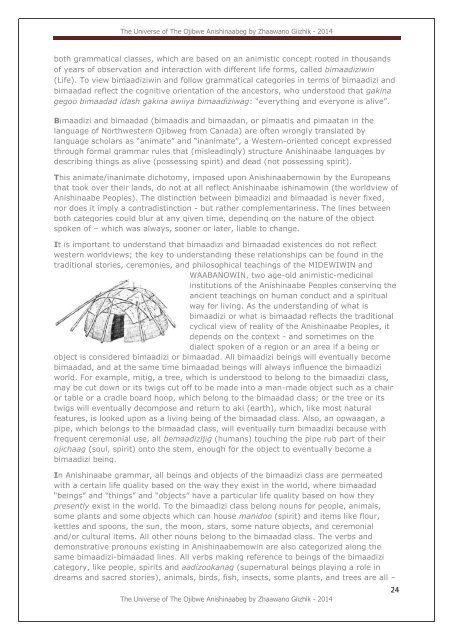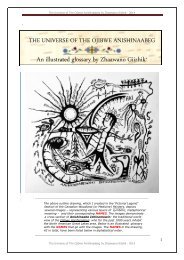The Universe Of The Ojibwe Anishinaabeg, an illustrated glossary by Zhaawano Giizhik*
A Glossary written and illustrated by Native Woodland artist Zhaawano Giizhik demonstrating a cross section of Anishinaabe Izhinamowin: the traditional worldview of the Ojibwe Anishinaabeg, who for the past 2 millennia inhabit the North American Great Lakes area.
A Glossary written and illustrated by Native Woodland artist Zhaawano Giizhik demonstrating a cross section of Anishinaabe Izhinamowin: the traditional worldview of the Ojibwe Anishinaabeg, who for the past 2 millennia inhabit the North American Great Lakes area.
You also want an ePaper? Increase the reach of your titles
YUMPU automatically turns print PDFs into web optimized ePapers that Google loves.
<strong>The</strong> <strong>Universe</strong> of <strong>The</strong> <strong>Ojibwe</strong> <strong>Anishinaabeg</strong> <strong>by</strong> Zhaaw<strong>an</strong>o Giizhik - 2014<br />
both grammatical classes, which are based on <strong>an</strong> <strong>an</strong>imistic concept rooted in thous<strong>an</strong>ds<br />
of years of observation <strong>an</strong>d interaction with different life forms, called bimaadiziwin<br />
(Life). To view bimaadiziwin <strong>an</strong>d follow grammatical categories in terms of bimaadizi <strong>an</strong>d<br />
bimaadad reflect the cognitive orientation of the <strong>an</strong>cestors, who understood that gakina<br />
gegoo bimaadad idash gakina awiiya bimaadiziwag: “everything <strong>an</strong>d everyone is alive”.<br />
Bimaadizi <strong>an</strong>d bimaadad (bimaadis <strong>an</strong>d bimaad<strong>an</strong>, or pimaatis <strong>an</strong>d pimaat<strong>an</strong> in the<br />
l<strong>an</strong>guage of Northwestern <strong>Ojibwe</strong>g from C<strong>an</strong>ada) are often wrongly tr<strong>an</strong>slated <strong>by</strong><br />
l<strong>an</strong>guage scholars as “<strong>an</strong>imate” <strong>an</strong>d “in<strong>an</strong>imate”, a Western-oriented concept expressed<br />
through formal grammar rules that (misleadingly) structure Anishinaabe l<strong>an</strong>guages <strong>by</strong><br />
describing things as alive (possessing spirit) <strong>an</strong>d dead (not possessing spirit).<br />
This <strong>an</strong>imate/in<strong>an</strong>imate dichotomy, imposed upon Anishinaabemowin <strong>by</strong> the Europe<strong>an</strong>s<br />
that took over their l<strong>an</strong>ds, do not at all reflect Anishinaabe ishinamowin (the worldview of<br />
Anishinaabe Peoples). <strong>The</strong> distinction between bimaadizi <strong>an</strong>d bimaadad is never fixed,<br />
nor does it imply a contradistinction - but rather complementariness. <strong>The</strong> lines between<br />
both categories could blur at <strong>an</strong>y given time, depending on the nature of the object<br />
spoken of – which was always, sooner or later, liable to ch<strong>an</strong>ge.<br />
It is import<strong>an</strong>t to underst<strong>an</strong>d that bimaadizi <strong>an</strong>d bimaadad existences do not reflect<br />
western worldviews; the key to underst<strong>an</strong>ding these relationships c<strong>an</strong> be found in the<br />
traditional stories, ceremonies, <strong>an</strong>d philosophical teachings of the MIDEWIWIN <strong>an</strong>d<br />
WAABANOWIN, two age-old <strong>an</strong>imistic-medicinal<br />
institutions of the Anishinaabe Peoples conserving the<br />
<strong>an</strong>cient teachings on hum<strong>an</strong> conduct <strong>an</strong>d a spiritual<br />
way for living. As the underst<strong>an</strong>ding of what is<br />
bimaadizi or what is bimaadad reflects the traditional<br />
cyclical view of reality of the Anishinaabe Peoples, it<br />
depends on the context - <strong>an</strong>d sometimes on the<br />
dialect spoken of a region or <strong>an</strong> area if a being or<br />
object is considered bimaadizi or bimaadad. All bimaadizi beings will eventually become<br />
bimaadad, <strong>an</strong>d at the same time bimaadad beings will always influence the bimaadizi<br />
world. For example, mitig, a tree, which is understood to belong to the bimaadizi class,<br />
may be cut down or its twigs cut off to be made into a m<strong>an</strong>-made object such as a chair<br />
or table or a cradle board hoop, which belong to the bimaadad class; or the tree or its<br />
twigs will eventually decompose <strong>an</strong>d return to aki (earth), which, like most natural<br />
features, is looked upon as a living being of the bimaadad class. Also, <strong>an</strong> opwaag<strong>an</strong>, a<br />
pipe, which belongs to the bimaadad class, will eventually turn bimaadizi because with<br />
frequent ceremonial use, all bemaadizijig (hum<strong>an</strong>s) touching the pipe rub part of their<br />
ojichaag (soul, spirit) onto the stem, enough for the object to eventually become a<br />
bimaadizi being.<br />
In Anishinaabe grammar, all beings <strong>an</strong>d objects of the bimaadizi class are permeated<br />
with a certain life quality based on the way they exist in the world, where bimaadad<br />
“beings” <strong>an</strong>d “things” <strong>an</strong>d “objects” have a particular life quality based on how they<br />
presently exist in the world. To the bimaadizi class belong nouns for people, <strong>an</strong>imals,<br />
some pl<strong>an</strong>ts <strong>an</strong>d some objects which c<strong>an</strong> house m<strong>an</strong>idoo (spirit) <strong>an</strong>d items like flour,<br />
kettles <strong>an</strong>d spoons, the sun, the moon, stars, some nature objects, <strong>an</strong>d ceremonial<br />
<strong>an</strong>d/or cultural items. All other nouns belong to the bimaadad class. <strong>The</strong> verbs <strong>an</strong>d<br />
demonstrative pronouns existing in Anishinaabemowin are also categorized along the<br />
same bimaadizi-bimaadad lines. All verbs making reference to beings of the bimaadizi<br />
category, like people, spirits <strong>an</strong>d aadizook<strong>an</strong>ag (supernatural beings playing a role in<br />
dreams <strong>an</strong>d sacred stories), <strong>an</strong>imals, birds, fish, insects, some pl<strong>an</strong>ts, <strong>an</strong>d trees are all –<br />
<strong>The</strong> <strong>Universe</strong> of <strong>The</strong> <strong>Ojibwe</strong> <strong>Anishinaabeg</strong> <strong>by</strong> Zhaaw<strong>an</strong>o Giizhik - 2014<br />
24





